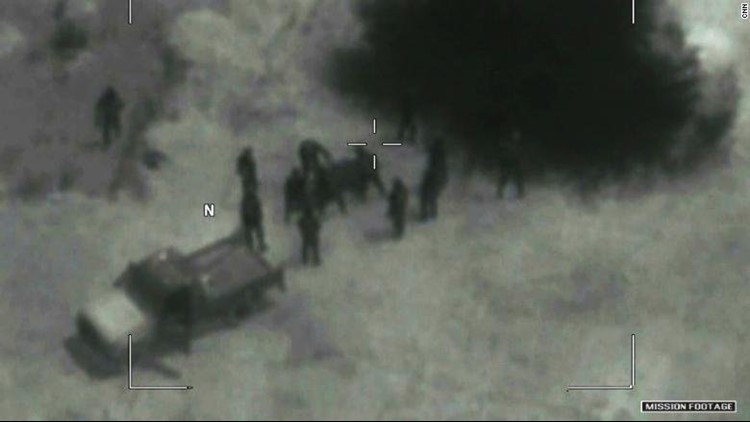A 23-minute video that was used to brief members of Congress on the October 2017 Niger ambush that killed four US soldiers and five Nigeriens provides new insight into what went wrong.
The video, produced by the US military and given to CNN by the Pentagon, comes on the heels of the summary of a classified 6,000-word US military report being made public last week.
The video, not previously released to the public, shows the body of Sgt. La David Johnson being recovered from under a thorn tree in Niger, 48 hours after he was killed in the ISIS ambush. Footage from a drone overhead showing Johnson’s recovery comes at the end of the video as Nigerien forces bring his body out from under a tree and prepare to load him into a truck to return him to American forces.
Defense officials said this portion of the video has been shown to the Johnson family.
Johnson’s fate had captured national attention when it was revealed he could not be located for hours after the ambush. Based on evidence gathered at the scene, it is now clear he was separated from his unit, tried to get to a safe position but was overrun and killed.
The entire video which includes extensive details about the mission and the attack on the 12-member team and their partner Nigerien force had been shown to members of Congress as well as during military briefings on the seven-month investigation into the October 4 ambush.
The other Americans killed were Staff Sgt. Bryan C. Black, Staff Sgt. Jeremiah W. Johnson and Staff Sgt. Dustin M. Wright. Niger has not released the names of its soldiers who were killed in the attack.
Two staff officials in the Pentagon press office asked that the video of Johnson being recovered not be shown but the Pentagon ultimately decided to make it public after requests were made by the media.
For the first time, the video shows segments of the aftermath of the ambush taken by drones and aircraft overhead. The segments are labeled on the recording as “mission” footage indicating they show the actual event, according to two defense officials.
The footage shows a group of seven American and four Nigerien troops escaped the ambush after several minutes and fled into a swamp to establish their final defensive position. The video narrator notes they all believed at that point they were going to be killed.
“They wrote short messages to loved ones on personal devices, believing they would soon be overrun,” says the US military narrator.
The footage also shows one American step into a clearing waving a US flag to signal the group’s identity. “French helicopters arrived in the vicinity at 1600 hours and searched for the team for 40 minutes. A team member moved into a clearing, waved an American flag to the helicopters to establish their identity as friendly forces,” the narrator says.
What had not been revealed is what happened when another Nigerien military team came to rescue them but did not realize they were not ISIS fighters. That force “arrived by vehicle at the team’s location and mistook the team for enemy forces, firing on them for 48 seconds with automatic weapons until they were positively identified. Fortunately no one was injured further,” according to the military narrator.
The video also has reveals more detail than was previously revealed by the Pentagon about the fact the mission was not properly authorized and how it diverged from the original plan.
The video suggests that the team that was ambushed had received intelligence that an ISIS commander was possibly moving into their area. They submitted a mission plan to conduct reconnaissance of the area but were actually planning to go after the ISIS commander according to the military narrator.
The narration bluntly says that there was an “inaccurate mission plan.” The summary published by the military made clear the team was not authorized or equipped to conduct risky capture and kill missions.
After failing to encounter any enemy forces the team was re-tasked by headquarters in Chad to conduct another mission and eventually ordered to investigate an abandoned encampment. The ambush happened hours later after they had left the village of Tongo Tongo on their way back to their base.
CNN has also learned that the intelligence about the ISIS commander that the team was utilizing in part came from information given to the military by the CIA including electronic intercepts, as was routinely the case in that area. Similar information was provided to another special operations team that was qualified to conduct that type of raid but that team never made it to its target because it was turned around. Officials have said they believe it faced weather issues.
For months Intelligence officials have emphasized that they did not order the military to conduct the mission. They only provided intelligence about the area.
The US military’s extreme sensitivity about the entire incident has only grown since October. US Special Operations Command is now reviewing the 6,000 page report and considering possible disciplinary against some of those involved.



